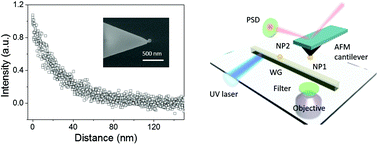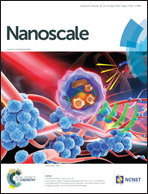Gap controlled plasmon-dielectric coupling effects investigated with single nanoparticle-terminated atomic force microscope probes†
Abstract
Precise positioning of a plasmonic nanoparticle (NP) near a small dielectric surface is not only necessary for understanding gap-dependent interactions between a metal and dielectric but it is also a critical component in building ultrasensitive molecular rulers and force sensing devices. In this study we investigate the gap-dependent scattering of gold and silver NPs by controllably depositing them on an atomic force microscope (AFM) tip and monitoring their scattering within the evanescent field of a tin dioxide nanofiber waveguide. The enhanced distance-dependent scattering profiles due to plasmon-dielectric coupling effects show similar decays for both gold and silver NPs given the strong dependence of the coupling on the decaying power in the near-field. Experiments and simulations also demonstrate that the NPs attached to the AFM tips act as free NPs, eliminating optical interference typically observed from secondary dielectric substrates. With the ability to reproducibly place individual plasmonic NPs on an AFM tip, and optically monitor near-field plasmon-dielectric coupling effects, this approach allows a wide-variety of light-matter interactions studies to be carried out on other low-dimensional nanomaterials.


 Please wait while we load your content...
Please wait while we load your content...